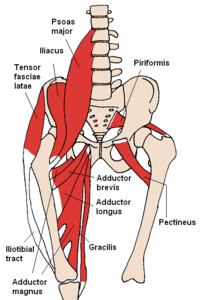Gracilis muscle
| Gracilis muscle |
|---|

|
| origin |
| Pubic bone ( ramus inferior ossis pubis ) |
| approach |
| Shinbone ( Pes anserinus superficialis ), Fascia cruris |
| function |
| Humans: flexion of the hip joint and knee, adduction of the thigh, inward rotation of the lower leg Animals: v. a. Adductor |
| Innervation |
| Obturator nerve |
| Spinal segments |
| L2, L3 |
The gracilis ( latin ; German "lean muscle" Slim muscle ) is a near-surface skeletal muscle of the thigh and one of his adductor . An archaic anatomical name for the muscle is "virgin guardian" (lat. Musculus custos virginitatis ) due to its "access-blocking" function to the female sex organ .
function
The area of action of the lean muscle extends over the hip joint and the knee joint . In the hip joint he bends the thigh and pulls it towards the middle of the body ( adduction ), in the knee joint he bends the lower leg and turns it inwards ( medial ).
In quadruped mammals, it is primarily an adductor, and in some cases it also acts as an extensor of the knee joint . In animals for slaughter, the muscle is part of the upper shell .
Clinical significance
The gracilis muscle is used in surgery as a free flap to reconstruct soft tissues. In plastic surgery, due to its properties, it is used in particular for the reconstruction of small breasts in particularly thin women or women who have already been operated on on the abdomen ( transversal myocutaneous gracilis flap, TMG flap). In surgical interventions on the shoulder, the slender muscle is used to secondary stabilize old shoulder joint dislocations that were not primarily treated.
See also
- short adductor ( musculus adductor brevis )
- long adductor ( musculus adductor longus )
- large adductor ( adductor magnus muscle )
- Comb muscle ( Musculus pectineus )
Individual evidence
- ↑ Thigh muscles , Section 3.2.2, medi-learn.de (PDF)
- ↑ Franz-Viktor Salomon: muscle tissue . In: Anatomy for veterinary medicine . 2nd ext. Edition. Enke, Stuttgart 2008, ISBN 978-3-8304-1075-1 , pp. 147-234.
- ↑ Heinz Bohmert, Christian J. Gabka: Plastic and reconstructive surgery of the breast: color atlas of surgical techniques . 2nd Edition. Georg Thieme, Stuttgart 2006, ISBN 978-3-13-155922-7 , pp. 181-182.